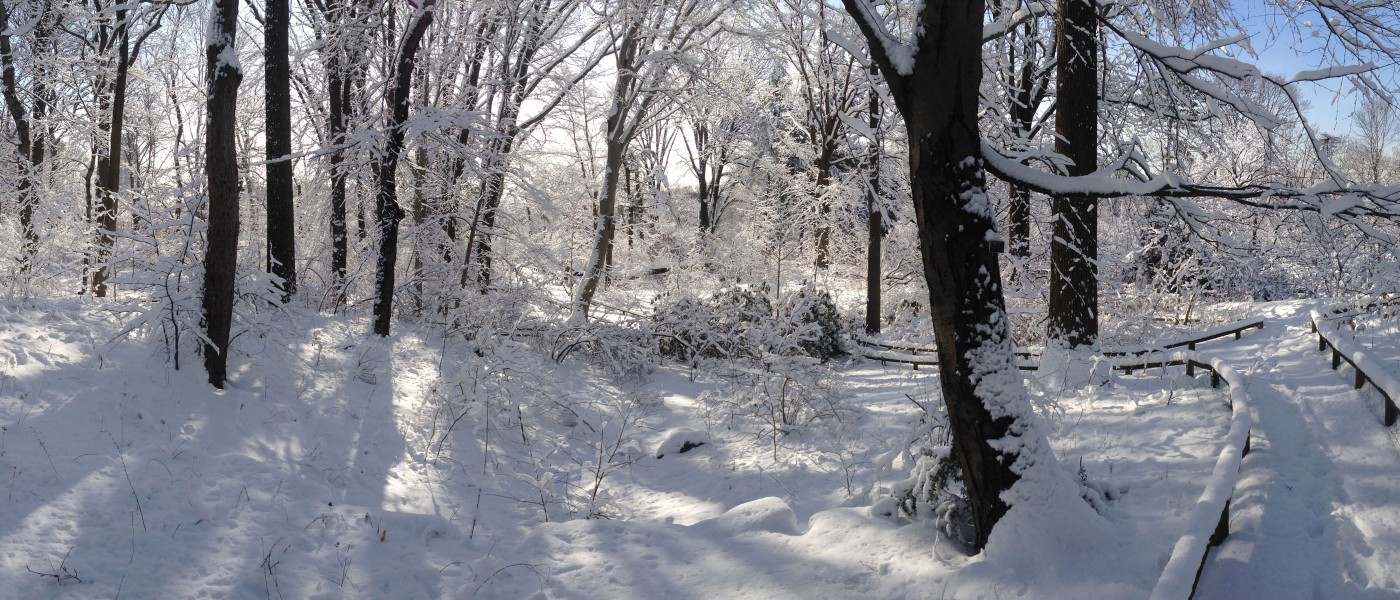The Quiet Earth: The Native Flora Garden in Winter
When you step into the Native Flora Garden, no matter what season, you feel a sense of wonderment and mystery. It looks and feels like a forest. During summer months, the garden pulses with activity—flying insects buzz, lush growth sways in the warm breeze, the smells are intoxicating. It’s as if you’re standing on the heartbeat of nature. During the winter months, with its bones laid bare, the garden takes on a much different mood.
It’s peaceful and quiet. But it retains a paradoxical sense of being both alluring and terrifying. How is it that a garden can evoke such a range of feelings? To begin to understand, maybe we should look back to a time when the ecosystems we’ve replicated here thrived throughout the region. As New York City expanded from its beginnings as a Dutch trading post, the forest boundary was pushed farther and farther away from the center of human activity. Today, we urbanites have grown almost completely out of touch with the spirit and legend of the forest. These days, first graders are sometimes scared to step into the Native Flora Garden when they arrive.
Forests still evoke powerful feelings after all. The thrill people once got from the shadowy, sylvan darkness has all but disappeared from our modern lives, but a visit to the winter woods can help us reconnect, in some small way, with our natural and cultural heritage. The short days of winter show a forest unclothed. The bare trunks of trees reveal nature’s architecture—buttressed root flares; stark outlines of branches and twigs against the sky; rough, textured bark. Towering treetops, hidden from view during summer, become eerie. There is a distinct stillness in the air, but what appears as a “dead” landscape is anything but.
So where are the animals, and what are the plants doing? Where are the signs of life during the winter? They can be found, for one, in the Hugo De Vries sweet gum (Liquidambar styraciflua), planted over 100 years ago by the eminent Dutch botanist and scientist for which it was named. This tree has stood on this patch of earth for a century, both feeding upon it and nourishing it. Its gnarled branches and misshapen burls bear the scars of history healed over, and it has risen to a strange perfection through the bending and warp of age.
During winter, the sweet gum’s majestic external structure is most apparent, but many seasons of feast and famine are concealed within its trunk and branches. Inside, unseen rings chronicle the fat years and lean times as the tree added more growth in years with abundant rain and nourishment and less during droughts. Trees harbor many other secrets too. The De Vries sweet gum, in its old age, yields cozy compartments in which black squirrels and raccoons take refuge from biting winter winds. The only evidence of their presence is revealed when there is a touch of hoarfrost or a dusting of powdery snow, when tiny paw prints lead to and from the massive trunk, showing that these animals have used the garden’s path as a highway to buried treasures and frozen morsels.
And deep within the trunk, the cycle of rebirth is under way in the nests these creatures have made. They will eventually cease to be winter dwellings and become nurseries instead, when newborns arrive in the spring. It’s all part of the ageless rhythm of birth and death, one that is reliable and full of hope. These animals and their nests are part of something ancient and bigger than our daily lives. Underground, plants are forming buds in anticipation of spring. In May, drifts of mayapples, ferns, and purple trillium will thrive beneath the sweet gum in the shade provided by its leafy boughs. Now, in winter, the thick rhizomes of trillium are beginning to grow a new set of roots.
At one end, a fat bud emerges and elongates, stopping just below the surface of the soil. Within, three leaves and a dark maroon flower are ready to burst forth as soon as winter is over. Many other spring ephemerals follow this model of growth. It allows them to take advantage of early sunlight in the forest once spring has arrived. Meanwhile, nestled in the axil of a nearby spicebush, a curious egg case appears. It looks like a brown marshmallow and feels like Styrofoam. I have seen others all over the garden. It belongs to the praying mantis, a fearsome but beneficial insect. Seeing one makes me smile; such egg cases are signs of a balanced ecosystem, where plants and the diverse community of insects and wildlife they sustain live in harmony.
A sense of connectedness, hope in the future, a reliable rhythm, signs of rebirth—these are the qualities of the forest that will always lure us in. The only way to reacquaint oneself with nature is to spend time immersed in it. Take the time to walk in the Native Flora Garden and be sure to keep your eyes and ears open. You may be silent, but there will be singing all around you.


